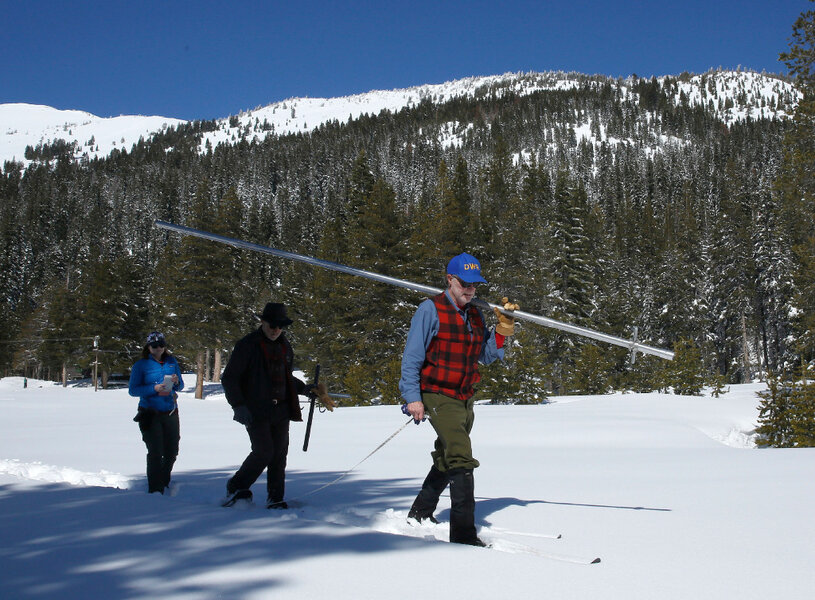Does California's 'phenomenal' snowpack spell the end of its water woes? Not quite.
Loading...
When California’s chief snow surveyor measured the snowpack near Lake Tahoe on Wednesday, he found 10 feet of snow at a spot that had been barren at the height of the state’s five-year drought.
It’s “pretty phenomenal,” Frank Gehrke told reporters about this season’s snowfall.
Indeed, two storms this year have brought the water content of the statewide snowpack up to 185 percent the normal level, approaching a record set all the way back in 1983.
But is that enough to bring the state back from a historic five-year drought that parched farms, ski resorts, and suburban lawns? Not quite.
For one, the type of storms that have battered the state haven’t been ideal for melting the snow level at a steady pace throughout the year. And the threat of climate change over the coming years looms large over Western states' water supplies, already strained by unforeseen urban growth.
“Water has been getting harder to find for urban and rural residents alike,” The Christian Science Monitor’s Zack Colman reported last week, writing about a proposal to drain a Nevada town north of Las Vegas of its water. “Even with big snows and rains across parts of the West this winter, aquifers and forests remain taxed. Long term, the water challenges of the American West look increasingly beyond the scale of traditional infrastructure projects to resolve.”
As of Wednesday, the average snowpack across California’s 400 miles of mountains was at 185 percent of normal conditions for the first day of March and 163 percent of the April 1 average, according to the state Department of Water Resources. At the southern end of the Sierra Nevada, with the highest mountain peaks, 201 percent of the normal amount of snow has piled up.
While no snow is in the short-term forecast, winter storms are expected to continue to fall on the state’s mountains in March and likely April as well. This puts California on pace to near or break the record set in 1982-83.
All this snow is not just a relief for skiers and fishermen. The snow that has accumulated along the 400-mile-long mountain range provides roughly 30 percent of California’s annual winter supply, providing a steady rush of water into the spring and summer, according to The Mercury News in San Jose. But the deluge of snow this winter hasn’t come in an ideal form.
Officials would prefer more traditional storms that flow south from the Gulf of Alaska, according to the Los Angeles Times. Those cold storms bring snow to lower elevations and pile up snow that will melt at a steadier pace throughout the year. Warmer “atmospheric rivers,” on the other hand, flow east from the Pacific, melting snow and contributing to sudden flooding. The constant stream of “atmospheric river” events this winter has caused a nightmare for reservoirs and rivers, including the Oroville Dam, the nation’s tallest. Both the main and emergency spillways of the dam suffered damage from torrents of water.
While the snowfall has ended the five-year drought for much of the state, climate change is also expected to drive water shortages throughout the West in the future, including earlier snowmelts and evaporation due to higher temperatures, experts say. This comes as urban centers are growing much faster and larger than “the original architects of the bedrock 1922 water-sharing agreement between the seven Colorado River basin states ever envisioned,” as Mr. Colman wrote last week. “Those urban centers now boast an economic output that overshadows agriculture, and development has strained water resources.”
But the region is innovating and adapting. Cities are encouraging desert-appropriate landscaping, asking residents to forsake their water-hungry lawns. Advancements in water treatment technology are making it more feasible to recycle water and harness rainfall. And farmers are also shifting to drip irrigation and other methods that use less water, as well as trading water through formal and informal market to use it more efficiently.
In the meantime, California can also look forward to an unseasonably long ski season. As much of the nation heads for the beach on Independence Day, Mammoth Mountain in the southern Sierra Nevada announced it will welcome skiers and snowboarders through July 4.
This report includes material from the Associated Press.







